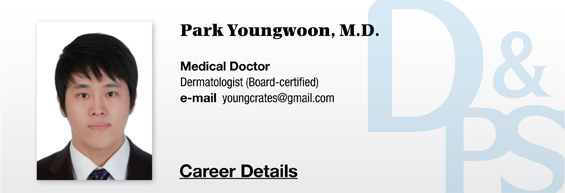3. Treatment and prognosis of laser toning-induced hypopigmentation
The prognosis and treatment outcome of LTID are not yet clearly understood. Various reports in the literature from the earliest to the latest have put forward widely varying explanations, without much consistency.2-6,23 One should note that most cases described as “irreversible” in the literature had received continued LT even after the onset of hypopigmentation or were followed-up for a short period of time. In our experience, appropriate countermeasures such as closely monitoring signs of hypopigmentation after each treatment and promptly discontinuing LT once it develops, generally lead to gradual improvement of LTID over months or years. (However, it is difficult to say that hypopigmentation will disappear in “all” patients or “complete” recovery can be achieved in most patients.)
Another hurdle is the lack of established guidelines for managing LTID. Few studies up to date have systematically examined indications and contraindications, expected efficacy, or outcomes and prognosis of several treatment modalities.
A large number of studies discussing treatment methods for LTID suggest reducing the color contrast between hypopigmented lesion and melasma lesion.2,25,27 In other words, one should strive toward repigmentation in the region of hypopigmentation and decreasing melanin pigment in melasma lesions for aesthetic improvement.
Many studies support phototherapy as an effective modality for repigmentation in hypopigmented lesions.2,21,22,26,27 Phototherapy is an important area of treatment in dermatology and is expected to revitalize impaired melanocytes and promote malanogenesis in LTID. In addition, many early studies on LT regarded LTID to be similar to punctate leucoderma caused by PUVA or PUVASOL (topical or oral psoralen followed by ultraviolet A irradiation or solar ultraviolet light exposure).2,6,24,27 And it may seem natural to apply phototherapy used in punctate leucoderma to LTID. Nevertheless, little is known about the effects, side effects, and outcomes of phototherapy in LTID, with only few case reports.2,27 Despite such a lack of evidence, phototherapy has been shown to be effective in hypopigmentation induced by traditional laser therapy,28 and many dermatologists are still using phototherapy to treat LTID. For this, focused narrow band ultraviolet B (NBUVB) and 308 nm excimer laser are mainly used. Again, not much is known about the difference between the two devices in terms of efficacy and side effects in the treatment of laser induced hypopigmentation. We believe localized and selective irradiation on hypopigmented lesion is more important than the wavelength. Light or laser in the UVB range emitted in hyperpigmented melasma right beside the hypopigmented lesion can worsen melasma and heighten the color contrast between lesions, resulting in dreadful cosmetic problems. Considering that the diameter of most hypopigmented lesions is 1-5mm, it is not practical to limit NBUVB irradiation to hypopigmentation. We believe this to be a limitation of NBUVB.
[Advertisement] MAGNUM(Q-switched Nd:YAG Laser) – Manufacturer: (www.i-dana.com)]
Fractional lasers can be considered promising means to induce repigmentation. For a long time, ablative/non-ablative fractional lasers have been researched and used to treat hypopigmented or depigmented disorders such as hypopigmented scars, striae distensae, and idiopathic guttate hypomelanosis.29-32 In vitiligo, fractional lasers have been used very cautiously due to the risks of post-laser inflammation that could worsen the disease or cause Koebner phenomenon.33 Combination of phototherapy and fractional laser have been able to achieve favorable results with minimal side effects.33 Not much is clearly understood about the mechanism in which fractional laser brings repigmentation in hypopigmented/depigmented lesions. But it was shown that heat-shock proteins, cytokines, and growth factors are produced to help wound healing after fractional photothermolysis.34,35 They are presumed to promote melanogenesis and recruit nearby healthy melanocytes.29,33 Moreover, fractional photohermolysis may help remove dysfunctional melanocytes in the hypopigmented lesion and induce migration of normal melanocytes from the surrounding normal tissues.31 In fact, matrix metalloproteinase-2 is known to promote melanocyte migration from surrounding healthy tissues.33 Considering these mechanisms and proven efficacy and safety in other hypopigmented diseases, fractional lasers can be used in the treatment of LTID.
References
27. Kim HS, Jung HD, Kim HO, Lee JY, Park YM. Punctate leucoderma after low-fluence 1,064-nm quality-switched neodymium-doped yttrium aluminum garnet laser therapy successfully managed using a 308-nm excimer laser. Dermatol Surg 2012;38:821-3.
28. Reszko A, Sukal SA, Geronemus RG. Reversal of laser-induced hypopigmentation with a narrow-band UV-B light source in a patient with skin type VI. Dermatol Surg 2008;34:1423-6.
29. Glaich AS, Rahman Z, Goldberg LH, Friedman PM. Fractional resurfacing for the treatment of hypopigmented scars: a pilot study. Dermatol Surg 2007;33:289-94.
30. Lee SE, Kim JH, Lee SJ, Lee JE, Kang JM, Kim YK, et al. Treatment of striae distensae using an ablative 10,600-nm carbon dioxide fractional laser: a retrospective review of 27 participants. Dermatol Surg 2010;36:1683-90.
31. Shin J, Kim M, Park SH, Oh SH. The effect of fractional carbon dioxide lasers on idiopathic guttate hypomelanosis: a preliminary study. J Eur Acad Dermatol Venereol 2013;27:e243-6.
32. Rerknimitr P, Chitvanich S, Pongprutthipan M, Panchaprateep R, Asawanonda P. Non-ablative fractional photothermolysis in treatment of idiopathic guttate hypomelanosis. J Eur Acad Dermatol Venereol 2015;29:2238-42.
33. Shin J, Lee JS, Hann SK, Oh SH. Combination treatment by 10 600 nm ablative fractional carbon dioxide laser and narrowband ultraviolet B in refractory nonsegmental vitiligo: a prospective, randomized half-body comparative study. Br J Dermatol 2012;166:658-61.
34. Starnes AM, Jou PC, Molitoris JK, Lam M, Baron ED, Garcia-Zuazaga J. Acute effects of fractional laser on photo-aged skin. Dermatol Surg 2012;38:51-7.
35. Orringer JS, Rittie L, Baker D, Voorhees JJ, Fisher G. Molecular mechanisms of nonablative fractionated laser resurfacing. Br J Dermatol 2010;163:757-68.
-To be continued






















